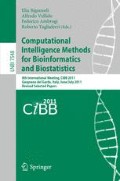Abstract
The elucidation of biological networks regulating the metabolic basis of disease is critical for understanding disease progression and in identifying therapeutic targets. In molecular biology, this process often starts by clustering expression profiles which are candidates for disease phenotypes. However, each cluster may comprise several overlapping processes that are active in the cluster. This paper outlines empirical results using methods for blind source separation to map the pathways of biomarkers driving independent, hidden processes that underpin the clusters. The method is applied to a protein expression data set measured in tissue from breast cancer patients (n=1,076).
Access this chapter
Tax calculation will be finalised at checkout
Purchases are for personal use only
Preview
Unable to display preview. Download preview PDF.
References
Li, H., Sun, Y., Zhan, M.: The Discovery of Transcriptional Modules by a Two-Stage Matrix Decomposition Approach. Bioinformatics 23(4), 473–479 (2007)
Li, H., Zhan, M.: Unraveling Transcriptional Regulatory Programs by Integrative Analysis of Microarray and Transcription Factor Binding Data. Bioinformatics 24(7), 1874–1880 (2008)
Lutter, D., Ugocsai, P., Grandl, P., Orso, E., Theis, F., Lang, E.W., Schmitz, G.: Analyzing M-CSF Dependent Monocyte/Macrophage Differentiation: Expression Modes and Meta-Modes Derived from an Independent Component Analysis. BMC Bioinformatics 9, 100 (2008)
Schwartz, R., Shackney, S.E.: Applying Unmixing to Gene Expression Data for Tumor Phylogeny Inference. BMC Bioinformatics 11, 42 (2010)
Abd El-Rehim, D., Ball, G., Pinder, S., Rakha, E., Paish, C., Robertson, J., Macmillan, D., Blamey, R., Ellis, I.O.: High-Throughput Protein Expression Analysis Using Tissue Microarray Technology of a Large Well-Characterised Series Identifies Biologically Distinct Classes of Breast Cancer Confirming Recent cDNA Expression Aanalyses. Int. J. Cancer 116, 340–350 (2005)
Soria, D., Garibaldi, J.M., Ambrogi, F., Green, A.R., Powe, D., Rakha, E., Douglas-Macmillan, R., Blamey, R.W., Ball, G., Lisboa, P.J.G., Etchells, T.A., Boracchi, P., Biganzoli, E., Ellis, I.O.: A Methodology to Identify Consensus Classes from Clustering Algorithms Applied to Immunohistochemical Data from Breast Cancer Patients. Comput. Biol. Med. 40, 318–330 (2010)
Zhao, Y., Karypis, G., Fayyad, U.: Hierarchical Clustering Algorithms for Document Datasets. Data Min. Knowl. Disc. 10(2), 141–168 (2005)
Jarman, I.H., Etchells, T.A., Bacciu, D., Garibaldi, J.M., Ellis, I.O., Lisboa, P.J.G.: Clustering of Protein Expression Data: A Benchmark of Statistical and Neural Approaches. Soft Computing: A Fusion of Foundations, Methodologies and Applications 15(8), 1459–1469 (2010)
Lisboa, P.J.G., Ellis, I.O., Green, A.R., Ambrogi, F., Dias, M.B.: Cluster-Based Visualisation with Scatter Matrices. Pattern Recogn. Lett. 29(13), 1814–1823 (2008)
Paatero, P., Tapper, U.: Positive Matrix Factorization: A Non-Negative Factor Model with Optimal Utilization of Error Estimates of Data Values. Environmetrics 5(2), 111–126 (1994)
Lee, D.D., Seung, H.S.: Learning the Parts of Objects by Non-Negative Matrix Factorization. Nature 401(6755), 788–791 (1999)
Ding, C., Li, T., Jordan, M.I.: Convex and Semi-Nonnegative Matrix Factorizations. IEEE T. Patt. Anal. 32(1), 45–55 (2010)
Spirtes, P., Glymour, C., Scheines, R.: Causation, Prediction and Search, 2nd edn. MIT Press, New York (2000)
Goebel, B., Dawy, Z., Hagenauer, J., Mueller, J.: An Approximation to the Distribution of Finite Sample Size Mutual Information Estimates. In: IEEE International Conference on Communications, vol. 2, pp. 1102–1106. IEEE Press, New York (2005)
Author information
Authors and Affiliations
Editor information
Editors and Affiliations
Rights and permissions
Copyright information
© 2012 Springer-Verlag Berlin Heidelberg
About this paper
Cite this paper
Lisboa, P.J.G. et al. (2012). Discovering Hidden Pathways in Bioinformatics. In: Biganzoli, E., Vellido, A., Ambrogi, F., Tagliaferri, R. (eds) Computational Intelligence Methods for Bioinformatics and Biostatistics. CIBB 2011. Lecture Notes in Computer Science(), vol 7548. Springer, Berlin, Heidelberg. https://doi.org/10.1007/978-3-642-35686-5_5
Download citation
DOI: https://doi.org/10.1007/978-3-642-35686-5_5
Publisher Name: Springer, Berlin, Heidelberg
Print ISBN: 978-3-642-35685-8
Online ISBN: 978-3-642-35686-5
eBook Packages: Computer ScienceComputer Science (R0)

